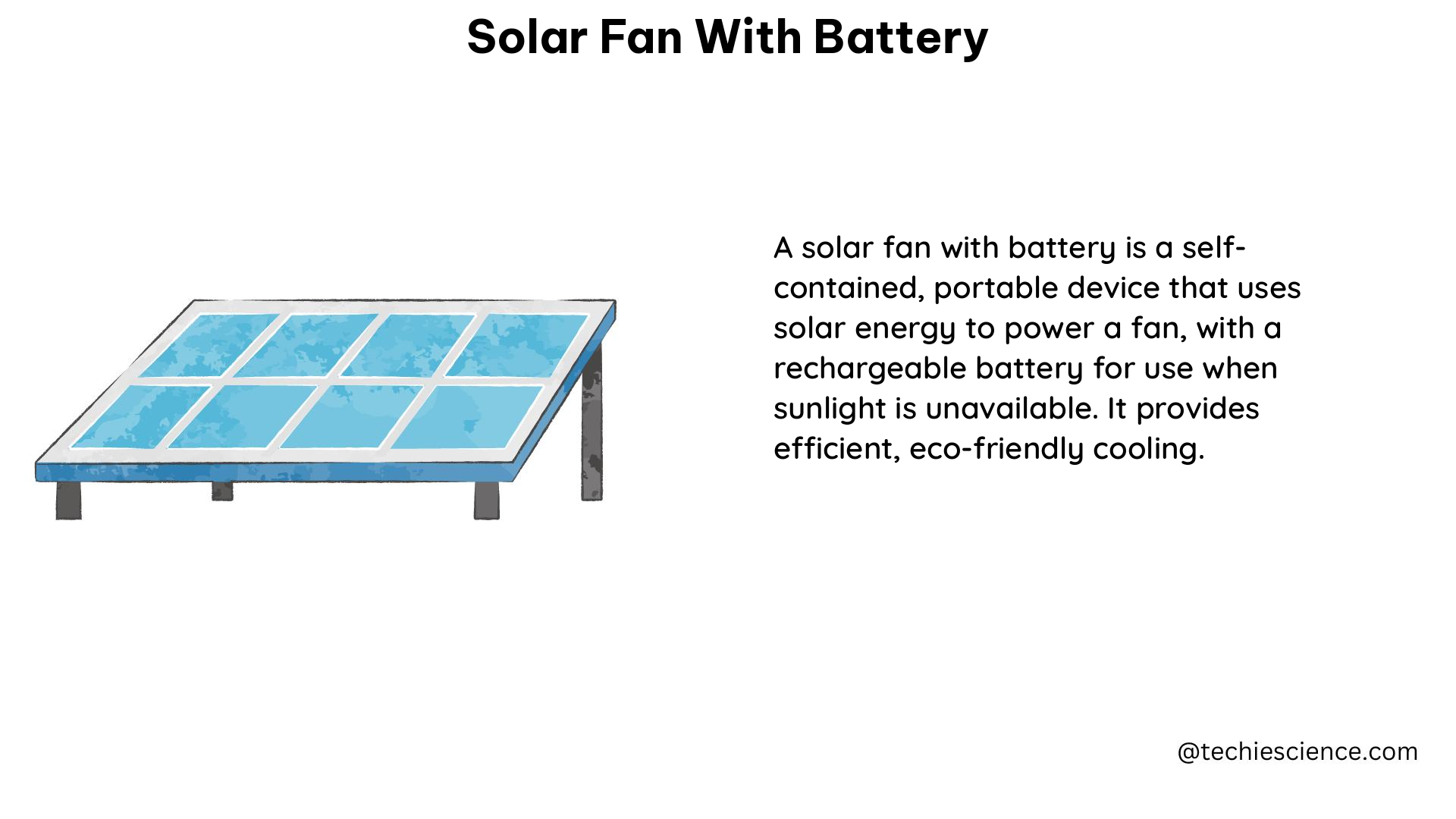A solar fan with battery system is a versatile and sustainable solution for off-grid ventilation needs. By harnessing the power of the sun and storing excess energy in a battery, this system can provide consistent airflow while reducing energy costs and environmental impact.
Understanding the Components
The key components of a solar fan with battery system include:
-
Solar Panel: The solar panel is the heart of the system, converting sunlight into electrical energy. The size and power output of the panel will depend on the specific application, ranging from small 4″x6″ panels with 200mA output to larger panels capable of several hundred watts.
-
Charge Controller: The charge controller regulates the charging and discharging of the battery, ensuring that it is not overcharged or deep-discharged. A Maximum Power Point Tracking (MPPT) charge controller can optimize the charging process, resulting in more efficient energy utilization.
-
Battery: The battery stores the excess energy generated by the solar panel during periods of high sunlight for use during low-light conditions. The battery capacity, measured in amp-hours (Ah), will depend on the system’s power requirements and runtime needs.
-
Fan: The fan is the primary load in the system, converting the electrical energy into airflow. The fan’s power consumption, measured in watts (W) or milliamps (mA), and its airflow rate, measured in cubic feet per minute (CFM), will determine the overall system design.
-
Switch: An optional switch can be added to the system to manually control the fan’s operation, allowing it to be run independently of the solar panel and battery.
Sizing the System

Determining the appropriate size for each component in the solar fan with battery system is crucial for ensuring optimal performance and reliability. Here are some key considerations:
Solar Panel
The solar panel’s size and power output should be selected based on the fan’s power consumption and the desired runtime. As a general rule, the solar panel’s power output should be slightly higher than the fan’s power consumption to ensure adequate charging of the battery.
For example, a small solar-powered attic fan may have a 4″x6″ solar panel with a 200mA output and a 7.2V voltage, while a larger industrial ventilation system may use a solar panel with several hundred watts of power.
Battery
The battery capacity should be chosen to provide the desired runtime for the fan during periods of low sunlight. A common rule of thumb is to size the battery to provide at least 2-3 days of runtime for the fan.
For a small 12Vdc fan with a power consumption of 60mA, a 12V, 10Ah battery would provide approximately 4 hours of runtime. For a larger system, a battery with a capacity of several hundred amp-hours may be required.
Fan
The fan’s power consumption and airflow rate should be matched to the system’s overall power capabilities. A small 12Vdc fan with a power consumption of 60mA and a flow rate of 2.17CFM may be suitable for a truck camper, while a larger industrial ventilation system may require a fan with several hundred watts of power and a much higher airflow rate.
Improving Efficiency with MPPT
The use of a Maximum Power Point Tracking (MPPT) charge controller can significantly improve the efficiency of the solar fan with battery system. MPPT controllers continuously monitor the solar panel’s output and adjust the charging parameters to extract the maximum power available, resulting in more efficient energy utilization and a more consistent fan speed.
Compared to a traditional charge controller, an MPPT controller can increase the system’s power output by up to 30%, leading to faster battery charging and more consistent fan operation.
Addressing Variability in Sunlight
One of the challenges with solar-powered systems is their dependence on the availability of sunlight, which can be variable. To address this, the solar fan with battery system can be designed with a small battery to store excess energy generated during periods of high sunlight for use during low-light conditions.
Additionally, the charge controller can be used to regulate the charging and discharging of the battery, ensuring that it is not overcharged or deep-discharged, which can extend the battery’s lifespan.
Technical Specifications
A typical solar fan with battery system may have the following technical specifications:
| Component | Specification |
|---|---|
| Solar Panel | 4″x6″, 200mA, 7.2V |
| Charge Controller | MPPT, 10A |
| Battery | 12V, 10Ah |
| Fan | 12Vdc, 60mA, 2.17CFM |
| Switch | Single pole, double throw |
Conclusion
A solar fan with battery system is a versatile and sustainable solution for off-grid ventilation needs. By carefully selecting the appropriate components and optimizing the system’s efficiency, this system can provide consistent airflow while reducing energy costs and environmental impact. With the right design and implementation, a solar fan with battery system can be a reliable and low-maintenance solution for a variety of applications.
References
- Adjusting Power to 24-Hour Fan that Uses Solar and Battery
- A Technical Report on the Construction of Two-Way Powered Solar Fan
- Solar Panel and Little Computer Fan
- Adding a Small Solar Battery to this Solar Fan
- Solar Fan with Dynamic Battery Backup for Constant Speed of Operation

The lambdageeks.com Core SME Team is a group of experienced subject matter experts from diverse scientific and technical fields including Physics, Chemistry, Technology,Electronics & Electrical Engineering, Automotive, Mechanical Engineering. Our team collaborates to create high-quality, well-researched articles on a wide range of science and technology topics for the lambdageeks.com website.
All Our Senior SME are having more than 7 Years of experience in the respective fields . They are either Working Industry Professionals or assocaited With different Universities. Refer Our Authors Page to get to know About our Core SMEs.